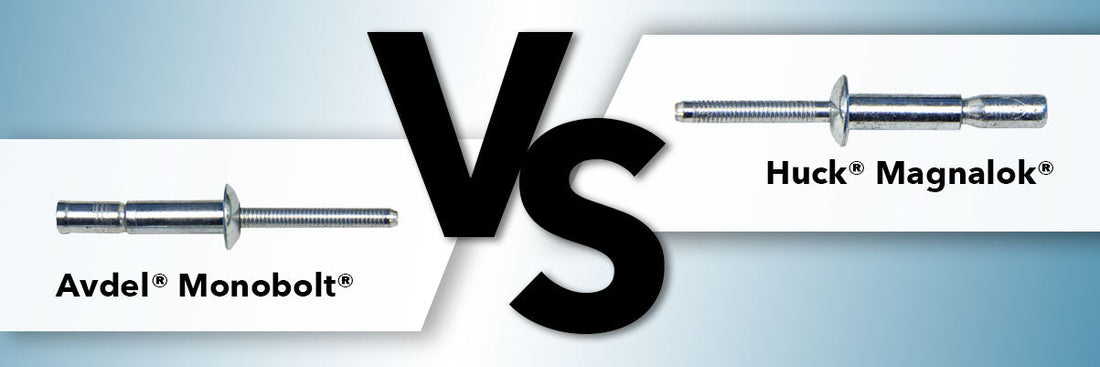At RivetLab, we aim to educate our distributors and customers. We ensure you have the right tools for the right job. With so many rivets on the market, it is easy to develop some misconceptions about the rivets available.
One prevalent misconception often occurs between the Huck MagnaLok® rivet and the Avdel Monobolt® rivet.
MagnaLok versus Monobolt
MagnaLok and Monobolt are two common styles of high-performance rivets, and they are sometimes confused. However, there are important differences between the two.
Both MagnaLok and Monobolt are well-known brand names. However, these rivet styles are also available from various manufacturers, including Gesipa®, FAR®, Huck®, POP®, and Ornit®.
Both rivets are available in various materials, including steel, stainless steel and aluminium. They have wide grip ranges and create a high-strength joint that prevents moisture ingress.
Key differences between MagnaLok and Monobolt
Huck Magnalok & Huck Gun
Huck rivets Magnalok style are easy to use. You need a standard rivet gun that provides sufficient pulling force. Good options include the FAR RAC171, GESIPA Taurus 3, Gesipa Powerbird Pro huck gun or Huck® bolt gun LH224 with a flat face nose tip.
These tools will help you install the blind rivet successfully. No special nose tip is required here because the locking mechanism is ingeniously engineered into the fastener. This unique design reduces errors, which saves time. You can easily check the proper installation with a quick visual inspection.
Other benefits of the Huck Magna-lok rivet include:
- Fast to install
- Compatible with standard tools
- Resistance to vibration and moisture
Avdel Monobolt
Avdel Monobolt rivets, however, require a specific nose tip to install and internally lock the mandrel. Without this nose tip, Monobolt rivets may not install correctly. This can lead to issues like the mandrel pulling completely through the rivet body. This causes the fastener to lose strength and fail to create a proper seal.
Benefits of Monobolt include:
- Protruding head or countersunk style
- Multi-grip capability
- High shear and tensile strength
- Visible lock for quick and easy inspection
- Compensates for irregular, oversized or misaligned holes
- Vibration resistant
So, how can you distinguish between MagnaLok and Monobolt? Although they appear similar, a closer examination will reveal their differences.
Huck® Magnalok®
- The head style of the rivet body features a rounded end.
- There is no counterbore where the flange meets the mandrel. A suitable flat nose tip will be appropriate.
Avdel® Monobolt®
- The head style of the rivet body features a flared end.
- There is a distinct counterbore where the flange meets the mandrel. This counterbore will accept the raised crown on the nose tip.

Manufacturers commonly use these rivets in various applications requiring structural joints. The Tesla Model S chassis extensively uses Huck® Structural Rivets.
Manufacturers use structural rivets to build Kenworth truck cabs and electrical enclosures. They also use them for aluminium ute trays, grain silos, and solar farms. Structural rivets are important for HVAC units, architectural facades, industrial roller doors, and security doors and windows.
We are always here to help you choose the right tool and fastener for the job. If you have questions, contact our knowledgeable sales and service team.
* Huck is a trademark of Howmet® Fastening Systems.
* Avdel is a registered trademark of Stanley® Engineered Fastening


